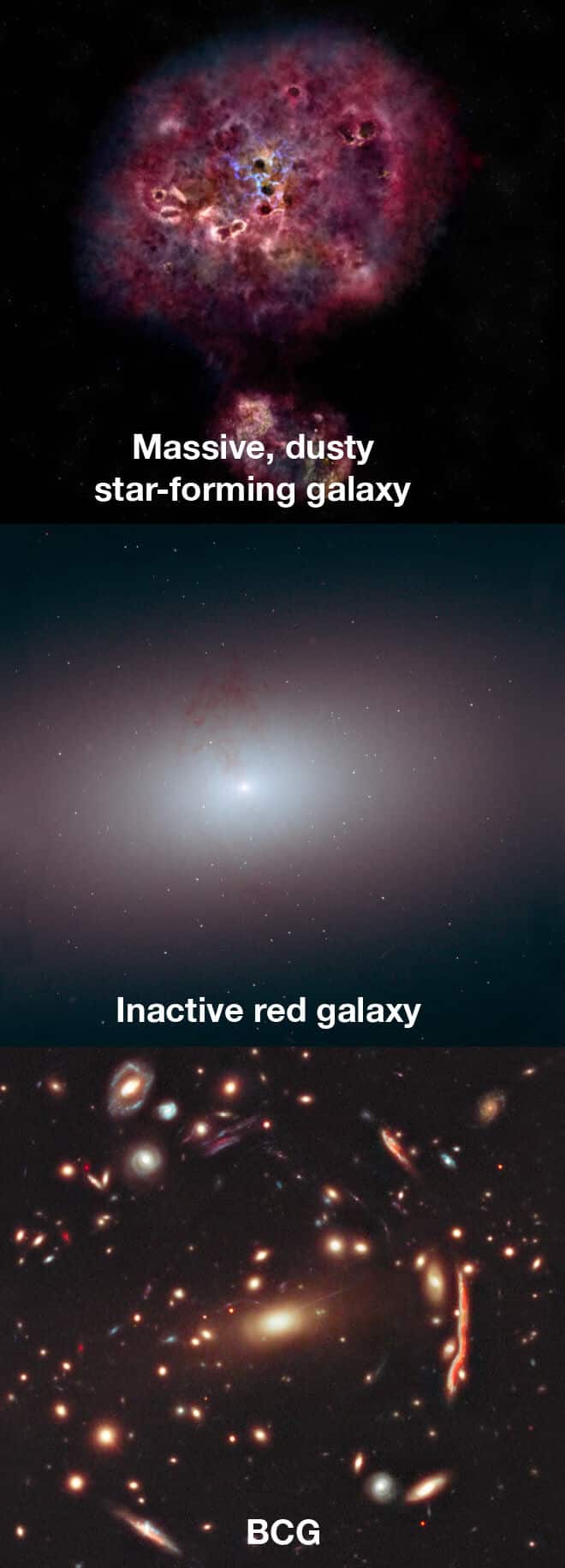An international group of astronomers led by scientists at the University of California, Riverside found an unusual monster galaxy that existed about 12 billion years ago, when the universe was only 1.8 billion years old.
The galaxy, named XMM-2599, formed stars at a high rate and then died. It is unclear why she suddenly stopped creating stars.

An international group of astronomers led by scientists at the University of California, Riverside found an unusual monster galaxy that existed about 12 billion years ago, when the universe was only 1.8 billion years old.
The galaxy, named XMM-2599, formed stars at a high rate and then died. It is unclear why she suddenly stopped creating stars.
"Even before the universe was 2 billion years old, XMM-2599 had already produced a mass of more than 300 billion suns, making it an ultramassive galaxy," said Benjamin Forrest, a postdoctoral researcher in the University of Riverdale's Department of Physics and Astronomy and lead author of the study. . "And what's more amazing, we show that XMM-2599 formed most of its stars in a giant binge when the universe was less than a billion years old, then became inactive when the universe was 1.8 billion years old."
What kills the galaxies?
The team used spectroscopic observations from MOSFIRE, the powerful infrared multi-object spectrograph at the Wu Observatory. M. Keck to make precise measurements of XMM-2599 and accurately quantify its distance. The results of the study appear in the Astrophysical Journal.
"In that time, very few galaxies have stopped forming stars, and none of them are as massive as XMM-2599," said Gillian Wilson, a professor of physics and astronomy at the University of Riverside in whose lab Forrest works. "The very existence of ultramassive galaxies like XMM-2599 is a big challenge for the numerical models. Although such massive galaxies are very rare at this time, the models predict them. The galaxies they predict, however, are still likely to be actively forming stars. The reason XMM-2599 is so interesting, unusual and surprising is that it is no longer forming stars, perhaps because it has stopped getting fuel or its black hole has become active. Our results require changes in the way models turn off star formation in early galaxies."
The research team found that XMM-2599 formed more than a thousand solar masses per year at its peak—a very high rate of star formation. The Milky Way, on the other hand, creates about one star per year.
"XMM-2599 may be the descendant of a population of dust galaxies that formed many stars in the very early universe, which new infrared telescopes recently discovered," said Danilo Marchesini, associate professor of astronomy at Tufts University and co-author of the study. The development trajectory of XMM-2599 is unclear.
"We caught the galaxy in the inactive phase"
"We caught XMM-2599 in its inactive phase," Wilson said. "We don't know what she will become to this day. We know she can't lose mass. An interesting question is what is happening around her. Over time, will it be able to gravitationally attract nearby star-forming galaxies and become a bright city of galaxies”?
Co-author Michael Cooper, a professor of astronomy at the University of California, Irvine, said this result is a very likely possibility. "Perhaps during the next 11.7 billion years of cosmic history XMM-2599 will become the central member of one of the brightest and most massive galaxy clusters in the local universe," he said. "Alternatively, she can continue to exist in isolation. Or there could be a scenario that lies between these two results."
The team was given more time at the Keck Observatory to continue investigating the unresolved questions raised by XMM-2599.
"We identified XMM-2599 as an interesting candidate using imaging alone," said co-author Mariana Annunziatla, a postdoctoral researcher at Tufts University. "We used Keck to better characterize and confirm the nature of the galaxy and help us understand how massive galaxies form and die. MOSFIRE is one of the most efficient and useful devices in the world for conducting this type of research."
More of the topic in Hayadan:

3 תגובות
This galaxy was a star on a scale we cannot describe. Large and unstable that reached the super nova stage in a relatively short period of time. What remains is a dusty globular galaxy.
A galaxy is made up of details. It doesn't sound likely that there will be a certain occurrence of the entire galaxy at the end of its days, after all, it is the galaxy's business that it constantly produces stars that grow old and die. It is unclear how the entire galaxy was shut down at once
Very interesting
It should be known that supermassive stars end their lives in a shorter time than main series stars.
Is it possible that similarly the lives of supermassive galaxies are shorter than the lives of "normal" galaxies, similar to the Milky Way? And that they consume their nuclear fuel in a shorter time, (about a billion years or so as reported in the article) and then collapse in a massive galactic explosion, into their core?
The question is what are the products of that super explosion?
A super massive black hole?
Splitting into a galaxy cluster?
For scientific research the solutions.